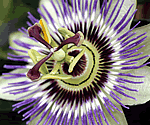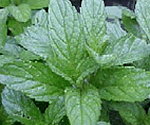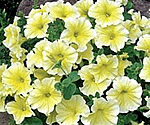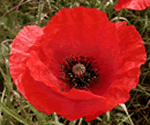
Pansy
A great deal of poetry and thought has been given to love, magic and the potential of floral aphrodisiacs. The humble pansy, when put over the eyes of a sleeping person, compelled him or her to pursue the first person they set eyes on in the morning. Dedicated to St. Euphrasia, the pansy is celebrated on this saint’s day, the 13th of March.
This flower of the ‘Viola’ family indicates deep thought. The upturned side petals and the large leafy stipules justify the name ‘pansy’ derived from the French “penser” which means ‘to think’. Pansies are available in assorted range of colours, such as, white, violet, and soft blue, purple and sometimes bi-coloured too. The common pansy was originally derived, long ago, from Viola tricolor hortensis, one of several species called heartsease and Johnny-jump-up. The Eastern field pansy is however, a separate species.

Passion Flower
Literally, the word ‘passion’ is derived from its Latin source ‘passio ‘ which means ‘to suffer’. In fact, passion indicates the sufferings on the cross and the death of Christ. In the world of flora, ‘passion-flower’ is any flower or plant of the genus Passiflora, consisting mostly of climbers of tropical and warm temperate America. Passiflora caerulea or ‘Constance Elliot’ is a white variant of the better-known blue passionflower.
The plant has an active principle called Passiflorine, used as a drug; in fact, it is known to be a depressant, with narcotic properties that helps in diarrhoea and dysentery, neuralgia, sleeplessness and dysmenorrhoea.
The passionflower is a vigorous frost-hardy climber with deep green divided leaves, and beautiful scented white, blue, pink and cerise flowers with creamy filament. It is called ‘passion-flower’ due to parts of the flower resembling the crown of thorns, nails and other symbols of Christ’s suffering. The passionflower is associated with faith, holy love, religious fervour and superstition. It is a prominent Christian flower symbol as its pointed leaf resembles a spear, the tendrils the whips, the column of the ovary signifies the cross and the dark circle of threads in the centre the crown of thorns. The flower portrays the passion of Christ. If the flower were white, as in the ‘Constance Elliot’ variety, it denotes piety; blue means heaven. The three days’ life span of the flower is supposed to mean – “so shall the son of man be three days and nights in the heart of the earth”

Peppermint
Often we have a mint to freshen our mouths. The peppermint flower is used as a special symbol. It indicates warmth of feeling, a snug comfortable state. This flower comes from an aromatic and pungent species of the mint family, Mentha Piperita. In fact, the true mints belong to the genus Mentha. Commercially the most important species of this genus is the peppermint (M. piperita).
The leaves and tops are sometimes dried and utilized for flavouring and in medicine. The liquor distilled from this strong-something herb is an oil extremely in demand as a carminative and stimulant and for its derivative menthol as well as for flavouring purposes, especially in chewing gum and candy. It is used in the preparation of medicine as a disguise for disagreeable tastes of drugs. Even the leaves of this plant are used as an amazing digestive respiratory and immune stimulant. It helps in matters of nausea, irritable bowel, and headaches. So next time, you suck on a mint, be aware of the significance attached to it!

Petunia
The petunia is an invaluable showy half hardy annual, which blooms from late spring to late autumn. These plants are drought resistant, always planted in full sun in a protected position. They need good drained soil, a trifle loamy and need to be kept away from the danger of frost. The flowers are saucer shaped or trumpet like according to the many varieties of petunia.
The colours are bright and vivacious full of life and vigour in shades of pink, ruby, purple, white and yellow sometimes striped or veined. The grandiflora petunias produce long trailing stems, which look a pretty contrast with the glowing colours of the blossoms. Petunia when gifted to someone shows haughty resentment mixed with anger at something the receiver has inadvertently done.
Of course, a petunia is also suggestive of a charming presence as if the flower seems to whisper lovingly to the beloved “Your presence soothes me!” what a unique way to praise your loving one!

Poppy
Keats imagined mellow autumn personified as a harvesting woman holding a sickle, half-asleep in a field of beautiful poppies. Yes, the poppy is associated with opium and therefore generally symbolical of eternal sleep and oblivion.
Poppy is the common name for some members of the Papaveraceae, a family composed chiefly of herbs of the Northern Hemisphere having a characteristic milky or coloured sap. The poppy flower is a brilliant coloured though short-lived blossom. Many of the species have several varieties and show a wide range of colours, especially in red, yellow, and white shades. The most frequently cultivated forms are the Oriental poppy (P. orientale), usually bearing a large scarlet flower with a purplish black base, and the corn poppy (P. rhoeas).
The latter is also known as the red poppy, scientifically termed Papaver Rhoeas, which is very slightly narcotic. In the language of flowers, the red petals are suggestive of deep pleasure.
The white poppy or Papaver somniferum is commonly referred to as the opium poppy. This variety of poppy is indigenous to Asia Minor. Hypnotic and sedative, this opium poppy or white poppy whispers words of affection. Opium is extracted from the poppy heads before they have ripened. From early times, the drug was well known to the Greeks and Romans. It is likely that the physicians of the Arabian school introduced the drug into India, as well as into Europe. It was initially used only as a medicine; the custom of opium eating first arose in Persia.
Opium is a valuable drug with two principal alkaloids, Morphine and Codeine, being its constituents.
Yellow poppies or Welsh poppies are an emblem of wealth and success. In the times of war, poppies became popular. ‘Poppy Day’ commemorates Armistice Day or Remembrance Sunday when artificial poppies are sold for charities.
